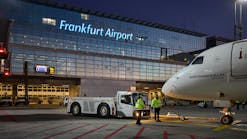The State of the Industry in 2025: Navigating a Changing and Challenging Landscape
The ground support industry is a critical facilitator of global air travel, and it finds itself at a pivotal juncture in 2025.
In 2023, the sector produced a global revenue of US$64 billion (equivalent to 7% of the global civil aviation value chain) and provided 1.1 million direct jobs (-12% compared to pre-pandemic levels), according to a recent report by ASA World and Steer Consulting.
The reports states ground support generated US$38 billion of gross value added (GVA), while its total contribution, including indirect and induced GVA, amounted to nearly US$100 billion.
As such, the industry plays a vital role in the safe and efficient operation of air travel and cargo shipment, however it faces a confluence of formidable challenges that demand innovative solutions and a renewed focus on sustainability.
Competition and a worsening workforce shortage
The ASA World report paints a sobering picture of the industry's current realities.
Chief among them, declining revenues over the past decade, driven by intense price competition from airlines, have severely constrained investment in crucial areas like innovation, training, and employee retention. This constant pressure to minimize costs has also hindered investment in new technologies and equipment, particularly those crucial for environmental sustainability.
Meanwhile, the industry grapples with significant workforce challenges, including recruitment and retention difficulties, high turnover rates, and a lack of skilled personnel. The absence of widely recognized and implemented industry standards for training and safety poses significant risks to operational safety and consistency.
“For too long, a race to the bottom has defined our business, with revenues declining by 4 percent annually over the past decade,” said Fabio Gamba, director general of ASA World. “This severely limits investment in innovation, training, and job retention, as employees face declining wages while productivity demand has increased by 17% in parallel.”
Key areas of focus
To navigate the currently challenging landscape, experts say ground handling companies must prioritize several key areas.
Technological transformation and digital integration are paramount, requiring the implementation of advanced technologies like robotics, artificial intelligence, and machine learning to automate repetitive tasks, improve efficiency, and enhance safety.
Leveraging data analytics to optimize operations, predict maintenance needs, and improve resource allocation is also crucial. Streamlining processes through the adoption of digital technologies, such as paperless documentation, real-time data sharing, and mobile applications, is essential for greater efficiency.
Workforce management and skill development are equally critical. Developing comprehensive training programs to equip employees with the skills necessary to operate advanced technologies and adapt to evolving industry demands is imperative.
Likewise, creating inclusive work environments that attract and retain a diverse workforce, fostering a culture of respect and equal opportunities, is essential. Implementing strategies to improve employee retention, such as competitive compensation packages, attractive benefits, and opportunities for career advancement, are vital to ensure a stable and skilled workforce.
Addressing economic pressures and managing costs effectively is another key challenge. Implementing lean operational strategies to minimize waste, maximize resource utilization, and improve overall efficiency is a priority.
Diversifying revenue streams beyond traditional ground handling services, such as offering ancillary value-adds like baggage handling for e-commerce, can provide additional income while cultivating long-term partnerships with airlines and airports to foster collaboration and explore mutually beneficial solutions.
Sustainability is critical
Transitioning to sustainable practices, such as investing in electric ground support equipment (GSE), exploring alternative fuels, and implementing sustainable waste management practices, is a key element in minimizing the industry's environmental impact.
According to the International Air Transport Association (IATA), a recent study focusing on Europe showed that, based on an average EU country’s electrical generation emission, electrically powered GSE produce 48% less CO2 emissions than GSE with internal combustion engines using traditional fossil fuels when operating under the same conditions.
Extrapolating this on a global scale and using 2019 traffic levels as a base, the ground handling industry could have reduced its CO2 emissions by 1.8 million tonnes per year if the GSE were all electrically powered, according to IATA.
Adopting GSE powered by cleaner energy will contribute positively toward reduced carbon emissions and noise emissions on the ramp, thereby improving working conditions.
That being said, fossil fuel is still the predominant energy source for commercial flight. As part of the Fly Net Zero by 2050 initiative, fuels are being developed that are produced from sustainable sources instead of fossil fuels.
According to information from IATA, a key element of decarbonizing the industry is the use of alternative fuels, such as fuels with lower carbon intensity. These fuels, or derivatives of them, are also viable for use in GSE.
While the use of electrically powered GSE is a goal, there are many places where the electricity supply and/or generating capacity is not sufficient or reliable enough to accommodate a wholesale switch from internal combustion engines to an all electrically powered GSE fleet. For this reason, alternative fuels which reduce CO2 footprint over their life cycle are being explored.
Pathways to success
Overcoming these challenges requires a multi-pronged approach. Prioritizing strategic investments in cutting-edge technologies to enhance operational efficiency, improve safety, and reduce environmental impact is on everyone’s mind.
Similarly, investing in comprehensive training programs, fostering a culture of continuous learning, and promoting diversity and inclusion within the workforce are essential for a skilled and engaged workforce.
Balancing technological advancements with environmental responsibility, prioritizing solutions that minimize environmental impact and promote sustainability, is paramount, and fostering strong relationships with airlines, airports, technology providers, and regulatory bodies to address common challenges and explore collaborative solutions is important for long-term success.
Optimizing GSE fleet utilization through pooling initiatives is one way to reduce redundancy and minimize environmental impact. Within this concept, a common pool of GSE is available for use by all ground handling service providers (GHSP) that operate at that airport.
According to IATA, GSE pooling can be particularly useful in reducing airside vehicle congestion by optimizing the GSE fleet on an airport-wide basis, rather than on a per-GHSP basis.
“This can eliminate the multiplication of the GSE peak time requirements and redundancies typically built into each GHSP’s fleet size calculations,” the IATA states. “It also facilitates the availability of specific specialized vehicles that are necessary but not frequently used, thereby avoiding duplication of expensive and under-utilized GSE.
“The economies of scale and standardization of the GSE fleet also simplifies fleet maintenance, reduces spare parts inventory, and simplifies driver and maintenance training. Then there are the potential savings from buying or leasing a larger fleet from one provider instead of smaller, varied fleets from several providers.”
Pooling GSE also makes it easier for an airport to comprehensively drive a switch to more sustainable energy sources.
On the horizon
The aviation ground support industry faces significant challenges in the years ahead. However, by embracing innovation, prioritizing sustainability, and fostering strong industry collaboration, ground handling companies can navigate these challenges and build a more resilient, efficient, and sustainable future for the sector.






